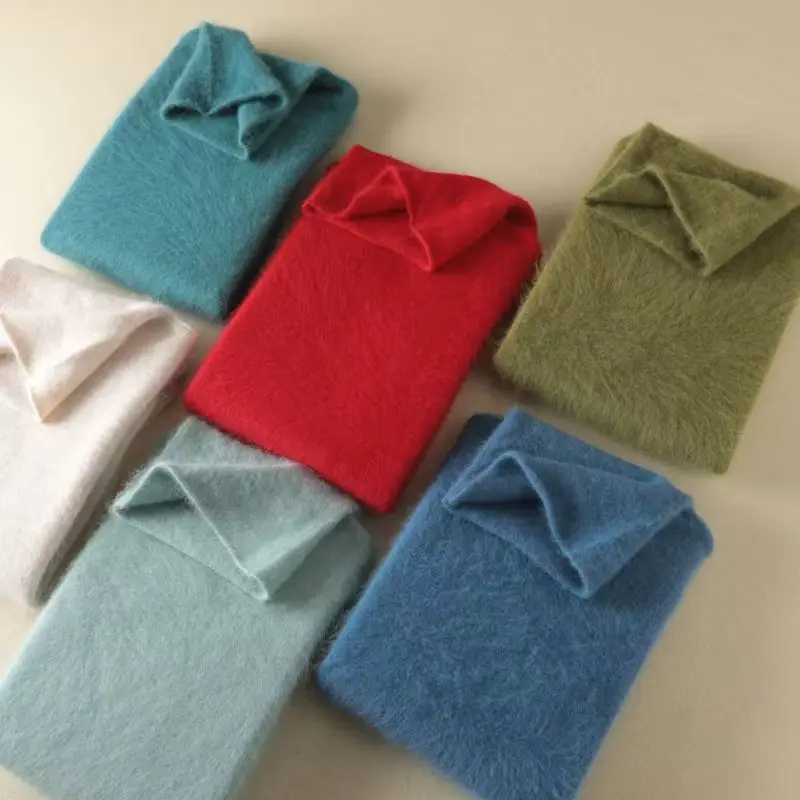Why Proper Cashmere Storage Matters
Cashmere is not just a fabric; it’s a luxury investment that deserves special attention. When you purchase a quality cashmere sweater, you’re investing in a garment that can provide warmth, comfort, and elegance for many years—but only with proper care and storage.
The way you store your cashmere directly impacts how long it maintains its luxurious qualities. The delicate nature of cashmere fibers makes them particularly vulnerable when stored improperly. These ultra-fine hairs (measuring less than 19 microns in diameter) can easily become damaged, misshapen, or even destroyed without the right storage techniques.
Improper storage leads to several unwanted consequences:
– Permanent stretching and distortion of the garment’s shape
– Fiber damage that causes pilling and thinning
– Pest infestations, particularly from clothes moths
– Loss of that signature soft, plush feel that makes cashmere so desirable
When stored correctly, high-quality cashmere sweaters can remain beautiful and wearable for decades. The effort you put into storing cashmere properly pays off significantly in the extended life and maintained quality of your luxury garments.
Essential Pre-Storage Preparation
Preparing your cashmere for storage is perhaps the most critical step in the entire process. Skipping or rushing this preparation virtually guarantees problems during storage, no matter how perfect your storage containers or environment might be.
Thorough Cleaning is Non-Negotiable
The most important rule of cashmere storage: never store a dirty sweater. Even if a garment appears clean, invisible soil, body oils, food particles, and perspiration residue attract moths and insects while promoting fiber breakdown.
For proper cleaning before storage:
- Hand washing (recommended): Use lukewarm water (85°F/30°C) with a specialty cashmere detergent or mild baby shampoo.
- Gentle technique: Soak for 10-15 minutes, then gently squeeze—never wring or twist.
- Thorough rinsing: Remove all soap residue with clean water at the same temperature.
- Careful drying: Press excess water out with towels, then lay flat on a fresh towel to dry completely.
- Patience is key: Allow 24-48 hours for complete drying before storage.
Professional dry cleaning is an alternative, but inform your cleaner that the garment is being prepared for long-term storage to avoid residual chemicals that might damage fibers over time.
The best way to clean cashmere sweaters involves gentle handling and patience, but this investment of time protects your investment in luxury.
Inspecting and Making Minor Repairs
Before storage, thoroughly examine your cashmere for any issues that need addressing:
- Check seams for loose threads or separation
- Examine high-friction areas (underarms, cuffs, elbows) for thinning
- Look for small holes that might enlarge during storage
- Identify pilling that should be removed
For pilling removal, use a specialized cashmere comb or high-quality fabric shaver—never regular scissors or razors. Gently work across the surface using light, consistent pressure to avoid damaging the underlying fibers.
Small holes or loose threads should be repaired before storage, as these minor issues can worsen over time. For significant damage, professional repair is worth the investment to preserve your garment.
The process of preventing and managing cashmere fuzz helps maintain the smooth texture that makes these garments so luxurious, both during wear and storage periods.
The Folding Method: Why and How
One of the most common mistakes in cashmere storage is hanging the garments. While convenient, hanging cashmere is a direct path to ruined sweaters. The weight of the fabric causes the shoulders to stretch irreversibly, creating unsightly dimples and distorted shapes that cannot be corrected.
Instead, folding is the only appropriate method for storing cashmere. Here’s the proper technique:
- Lay the sweater flat on a clean surface, front-side down.
- Fold one side toward the center (about 1/3 of the width).
- Repeat with the opposite side, creating a vertical trifold.
- Fold the bottom up toward the collar (either in half or thirds, depending on sweater length).
- Avoid sharp creases by keeping folds gentle and rounded.
For cardigans, button them before folding to maintain proper alignment. For pullovers with collars, place tissue paper at the fold to prevent sharp creasing.
Properly folded and stored cashmere maintains its shape beautifully. Remember that gravity is the enemy of cashmere—a hanging sweater can stretch 4-6 inches (10-15cm) over just one season.

Optimal Storage Conditions and Environment
The environment where you store cashmere is just as important as how you prepare and fold it. Four critical factors determine whether your storage location is suitable:
Cool temperature: 50-70°F (10-21°C) is ideal. Excessive heat weakens fibers and can encourage pest activity.
Dark storage: Direct sunlight or even bright artificial light causes fading and can weaken fibers over time.
Dry conditions: Humidity below 50% is essential. Moisture leads to mildew, mold, and musty odors that can be impossible to remove.
Adequate ventilation: Some airflow prevents moisture buildup while discouraging pests that prefer stagnant environments.
Problematic storage locations include:
– Attics (too hot in summer, temperature fluctuations)
– Basements (typically too humid)
– Garages (humidity, pest access, temperature swings)
– Plastic bins in closets (trap moisture, block ventilation)
The best locations in most homes are interior closets away from external walls, under beds in low-humidity bedrooms, or dedicated storage chests in temperature-controlled rooms. Preserving luxury cashmere requires creating these optimal conditions to maintain fiber integrity during storage periods.
Best Storage Containers and Materials
The container you choose creates the microenvironment that directly surrounds your cashmere. The right choice maintains optimal conditions while the wrong one can actively damage your garments.
| Container Type | Pros | Cons | Best For |
|---|---|---|---|
| Cotton Storage Bags | Breathable, prevents dust, affordable | Limited pest protection | Seasonal storage |
| Cedar Chests | Natural pest repellent, attractive, durable | Expensive, heavy, requires maintenance | Long-term storage |
| Acid-Free Boxes | Protects from light, stackable, prevents creasing | Less breathable, requires tissue lining | Long-term archival storage |
| Canvas Storage Bins | Breathable, durable, often collapsible | Limited pest protection, minimal structure | Seasonal storage |
The most important quality in any storage container is breathability. Cashmere needs to “breathe” even in storage, allowing minimal air exchange that prevents moisture accumulation.
When using boxes or chests, line them with acid-free tissue paper between each garment. This prevents color transfer and reduces friction between items. Never pack containers tightly—compressing cashmere damages fibers and prevents proper air circulation.
For most home storage situations, breathable cotton bags combined with proper moth prevention offer the best balance of protection and fiber health. Storing cashmere correctly with these materials extends garment life significantly.
Storage Materials to Avoid
Certain storage materials actively damage cashmere and should be avoided entirely:
- Plastic dry cleaner bags: Trap moisture and volatile chemicals that damage fibers
- Vacuum-seal storage bags: Compress and crush fibers, causing permanent flattening
- Regular cardboard boxes: Contain acids and lignin that transfer to and yellow fabrics
- Newspaper: The ink transfers to fabrics and the paper contains damaging acids
- Regular tissue paper: Often contains bleaching agents and acids harmful to fibers
- Cedar products without refreshing: Lose effectiveness over time if not maintained
Plastic is particularly problematic because it creates a moisture barrier that prevents evaporation. The resulting humidity inside the plastic becomes a perfect environment for mildew growth. Even seemingly dry garments release minute amounts of moisture that becomes trapped in non-breathable containers.
Following the ultimate guide to cashmere storage means selecting only materials that protect rather than harm your investment pieces.
Comprehensive Moth and Pest Prevention
Clothes moths represent the single greatest threat to stored cashmere. These pests specifically target animal fibers like cashmere, wool, and silk because they contain keratin, a protein that moth larvae consume.
Effective natural repellents include:
- Cedar products: Blocks, hangers, or chests containing aromatic oils that repel moths
- Lavender sachets: Using dried Lavandula angustifolia (English lavender) provides natural protection
- Rosemary, thyme, and cloves: Additional herbal deterrents that can be combined with lavender
- Regularly refreshed cedar oil: Maintains effectiveness of cedar products (every 3-6 months)

For existing infestations, the freezer method is highly effective:
1. Place cashmere in a sealed plastic bag
2. Freeze at 0°F (-18°C) for at least 72 hours to kill all lifecycle stages
3. Remove, allow to reach room temperature, then brush thoroughly before proper storage
Regular inspection is crucial—check stored items every 4-6 weeks for signs of pest activity like tiny holes, casings, or silky tunnels. Protecting cashmere from moths requires vigilance and preventative measures rather than trying to address infestations after damage occurs.
Short-Term vs. Long-Term Storage Strategies
Different storage durations require different approaches to protect your cashmere effectively:
| Storage Duration | Container | Moth Protection | Maintenance | Best Practices |
|---|---|---|---|---|
| Between wears (1-2 weeks) | Drawer with cedar lining | Minimal needed | Air out 24hrs before rewearing | Fold loosely, allow rest period |
| Seasonal (2-6 months) | Cotton bags or boxes with tissue | Lavender sachets or cedar | Monthly inspection | Complete cleaning before storage |
| Long-term (6+ months) | Cedar chest or acid-free boxes | Comprehensive natural repellents | Inspection every 8 weeks, airing every 3 months | Complete cleaning, tissue between folds |
For short-term storage between wearings, allow cashmere to “rest” for 24 hours before wearing again. This helps fibers recover from stretching and compression during wear.
For seasonal storage of cashmere, cleaning before storage is essential, while long-term storage requires additional layers of protection and regular maintenance checks.
Travel storage presents unique challenges—fold items with tissue paper at creases, use cotton storage bags, and place in the center of luggage surrounded by softer items for protection.
Cashmere Wrap Sweaters, Women's Cashmere Pullovers
$75.89 Select options This product has multiple variants. The options may be chosen on the product pageCashmere Cable Knit Sweaters, Women's Cashmere Pullovers
Price range: $111.82 through $112.93 Select options This product has multiple variants. The options may be chosen on the product pageCropped Cashmere Sweaters, Women's Cashmere Pullovers
$155.77 Select options This product has multiple variants. The options may be chosen on the product pageOversized Cashmere Sweaters, Plus Size Cashmere Sweaters, Women's V-Neck Cashmere Sweaters
$136.87 Select options This product has multiple variants. The options may be chosen on the product page- Price range: $108.11 through $130.03 Select options This product has multiple variants. The options may be chosen on the product page
Striped Cashmere Sweaters, Women's Cashmere Pullovers
$139.68 Select options This product has multiple variants. The options may be chosen on the product page
Maintaining Stored Cashmere
Even properly stored cashmere benefits from periodic maintenance to ensure continued protection:
3-Month Maintenance Schedule:
1. Remove from storage and inspect thoroughly
2. Gently shake and air out in indirect light for 1-2 hours
3. Refresh moth deterrents (replace lavender, reapply cedar oil)
4. Refold along different lines to prevent permanent creases
5. Return to storage with fresh tissue paper if used
When airing cashmere, avoid direct sunlight and high humidity. The goal is to release trapped moisture and refresh the fibers, not expose them to new risks.
Watch for early warning signs of problems during these inspections:
– Musty or unusual odors (indicates potential moisture issues)
– Tiny holes or dust (possible moth activity)
– Yellowing or color changes (improper storage materials or conditions)
This regular maintenance cycle is essential for the long-term preservation of cashmere fabric, particularly for cherished pieces you plan to keep for many years.
Common Storage Mistakes to Avoid
Be aware of these frequent cashmere storage errors that compromise even the most expensive garments:
- Storing without cleaning: Invisible soils attract pests and damage fibers over time.
- Using plastic containers: Traps moisture leading to mildew and fiber damage.
- Hanging instead of folding: Creates shoulder dimples and stretching that cannot be corrected.
- Overpacking storage containers: Compresses fibers and prevents necessary air circulation.
- Ignoring environmental factors: Storing in attics, basements, or humid areas accelerates deterioration.
- Relying on mothballs: These contain naphthalene or paradichlorobenzene, chemicals harmful to both cashmere and humans.
- Forgetting regular maintenance: Allowing problems to develop unchecked during long storage periods.
The question of whether cashmere should be hung or folded has a clear answer—proper folding is always superior for maintaining garment integrity during storage periods of any length.
Special Considerations for Different Cashmere Items
Different cashmere items require slightly modified storage approaches:
Scarves and Wraps
Rather than folding, loosely roll these items around acid-free tissue tubes to prevent creasing. Store horizontally in drawers or boxes with tissue between layers.
Hats, Gloves, and Accessories
Stuff with acid-free tissue to maintain shape before placing in storage containers. For hats, use specialized supports or create tissue forms to prevent flattening.
Oversized Garments
Oversized cashmere sweaters require additional support at fold points to prevent creasing. Use extra tissue paper at the folds and consider an additional layer of tissue between each folded section.
Embellished Items
Sweaters with beading, sequins, or decorative elements need special attention—place tissue paper over embellishments before folding to prevent them from catching on the fabric and creating pulls.

Cashmere Blends
Items containing cashmere blended with other fibers (like silk or cotton) should follow cashmere storage guidelines, as these are typically the most demanding fiber in the blend.
Is Your Current Storage Working? Signs of Success and Problems
Evaluate your storage methods by looking for these indicators:
| Success Signs | Warning Signs |
|---|---|
| Garment maintains original shape | Stretched areas or distortion |
| No unusual odors | Musty or chemical smells |
| Colors remain true | Fading or yellowing |
| Soft, plush feel retained | Stiff or rough texture developing |
| No signs of pests | Small holes or moth casings |
| No pilling beyond normal wear | Excessive pilling or fiber loss |
If you notice warning signs, take immediate action:
– For pest indicators, freeze the item immediately
– For odors, air the garment thoroughly before deciding on next steps
– For shape issues, try gentle reshaping while damp
– For severe problems, consult a professional textile conservator
High-quality pieces like women’s cashmere pullovers represent a significant investment and deserve storage methods that preserve their quality. Evaluating your storage success prevents costly damage and extends garment life.
Travel and Temporary Storage Solutions
Traveling with cashmere requires modified storage approaches:
For Short Trips:
– Fold with tissue at the creases to minimize wrinkling
– Place in breathable cotton bags within your luggage
– Position in the center of your suitcase, cushioned by softer items
– Avoid compression from heavier items
For Extended Travel:
– Consider portable cedar inserts for pest prevention
– Pack lavender sachets in resealable bags for protection
– Select accommodations with appropriate storage options
– Unpack and properly fold items upon arrival
Emergency Solutions:
– In humid environments, use hotel air conditioning to reduce moisture
– For unexpected storage needs, use clean cotton pillowcases as temporary storage bags
– If pests are a concern, keep items in sealed bags in freezer if available
These strategies ensure your cashmere turtlenecks and other luxury items remain protected even when you’re away from your normal storage system.
Proper cashmere storage is an investment of time that pays dividends in the extended life of your luxury garments. By following these guidelines from Estate Cloth, your cashmere collection will maintain its beauty, softness, and value for years to come.







